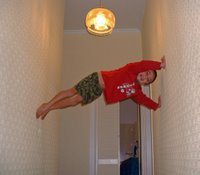Falls are exceptionally diverse in terms of their multiple causes, location of occurrence and effective prevention across the life-span.
http://www.nzips.govt.nz/priorities/falls.html
Gary Moller Comments:
Injuries resulting from falls are a world-wide epidemic and the problem is set to get much worse. This is because of the Baby Boomers hitting old age and the problem being eaxcerbated by the widespread drugging of the elderly with all kinds of medications on a scale never seen before. Adding to the problem on a grand scale is the sad fact that children are no longer learning the art of falling properly through what used to be normal play - play fighting, climbing trees, or playing bull-rush and scrag in the playground.
My experience of children nowadays is that few are able to do a basic forward roll without bumping their heads and landing awkwardly. Few have the muscle strength in their necks to counter the head-smashing whiplash that happens when falling over backwards and few have neither the technique nor the arm strength to break a forwards or side fall without fracturing an arm or wrist.
The usual approach to preventing falls is to progressively wrap our citizens in layer after layer of cotton wool. Such an approach, while partially effective, is abhorrent to the FreeRanger. The better approach, beginning with children, is teach them how to fall properly and, therefore, safely - and to ensure that they have the strength to go with the technique. This same approach can be applied with success to the elderly with the added strategy of ensuring that they are as medication free as possible and that any they must be on are not causing poor balance and frailty. Further measures include ensuring best nutrition, proper eyecare and a relatively hazard free environment.
It is easy and safe to teach a child how to fall because the wee body bounces really well without injury and the rapidly growing brain soaks up new skills like a dry sponge.
 Teach your child how to do a forward roll, wrestle on the floor. These activities teach kinaesthetic awareness (awareness of body position in time and space). Teach the "Flying Flambini" (carefully and progressively!). One way to strengthen a young body is to challenge them to do things like climbing the walls (Don't parents
Teach your child how to do a forward roll, wrestle on the floor. These activities teach kinaesthetic awareness (awareness of body position in time and space). Teach the "Flying Flambini" (carefully and progressively!). One way to strengthen a young body is to challenge them to do things like climbing the walls (Don't parents  of young children do that?). Climbing the walls builds awesome strength to weight.
of young children do that?). Climbing the walls builds awesome strength to weight.Take care: Be ready to catch because going up is much easier than coming down, or place something soft underneath like a very large cushion. Creeping up towards the ceiling and then dropping down from an ever increasing height teaches the child how to land and absorb impact without injury.
By teaching these kinds of skills and building strong muscles, bones and ligaments at the same time, you are preparing your child for an inury free life that is free of restrictive cotton wool.
2 comments:
amazing to think we used to play on playgrounds that were covered with concrete, no one thought twice about letting us play on those playgrounds with teh far greater risk of injury than children have today on playground surfaces. we all stubbed our toes and got bruised and grazed, obviously concrete and asphalt arent ideal surfaces because there still is the risk of brain injury from falls, but I dont think parents have anywhere near as much to worry about should their child fall off at the playground.
Our kids are lucky in comparison to overseas kids that most of them get the opportunity to play on the more forgiving surface of grass. In the future the grass sportsfields of NZ will do more to maintain nz health than possibly anywhre else in nz, children should be allowed to build the confidence to fall and have the confidence to take to the sports fields with that learned skill.
a child half the height of an adult falls with a sixteenth of the impact!
It would be a shame to see the sportsfields left idle through the strangulation of development of childrens ability to cope with the rough and tumble on open spaces.
we're extremely lucky in the unrestricted access we have to open spaces. but they are becoming less and less utilised possibly for this reason as much as other modern distractions. by the time our children grow into adults if they havent been habitual exercisers on their feet they will be behind the eight ball on their bone density and overall physical strength and already on the road to greater risk of injury and physical degeneration even earlier than their parents.
I spent years tramping over difficult terrain and rough tracks, spending days on end constantly negotiating tree roots, and mud puddles, steep clopes as did all my friends, we all took falls with heavy packs on our back the we'd automatically developed the coordination and sttrength to fall without injury, I only know one person who had a serious injury requiring hospitalisation, and that was because they were crossing a difficult waterfall.
we never thought about the risk, I think people should give the human body some credit if you give it the chance to develop pproperly.
who was the first person to climb everest?
Post a Comment